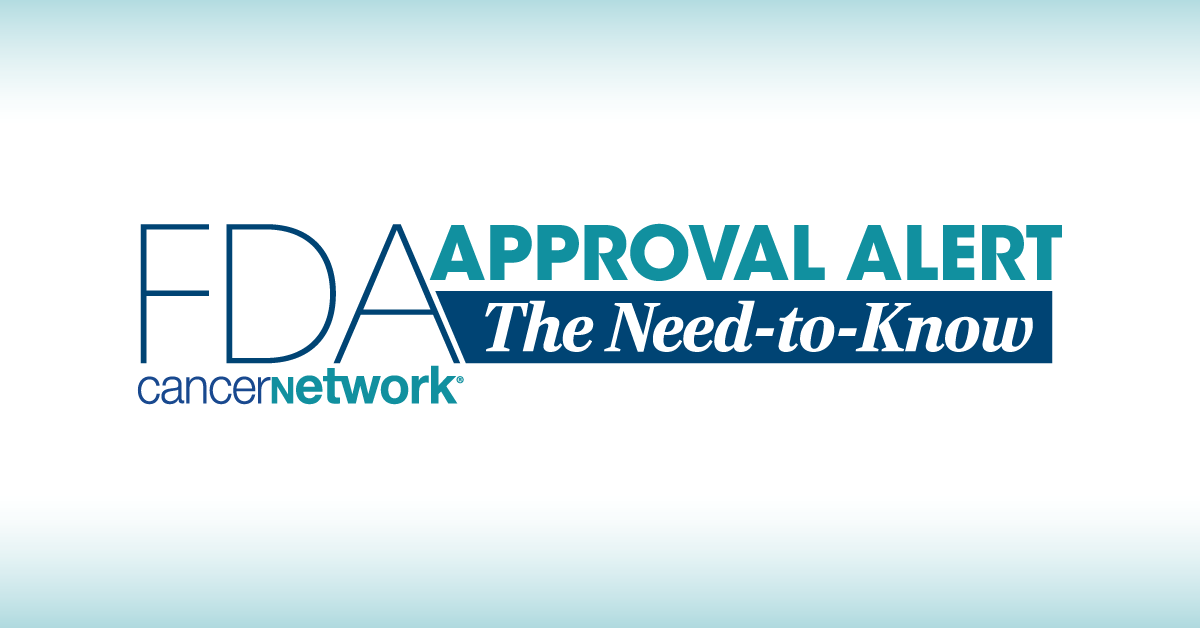FDA Approves Lurbinectedin/Atezolizumab Maintenance in ES-SCLC
Data from the phase 3 IMforte trial support the FDA approval of maintenance lurbinectedin plus atezolizumab in extensive-stage small cell lung cancer.
The regulatory agency based its decision on findings from the phase 3 IMforte trial (NCT05091567) evaluating lurbinectedin plus atezolizumab vs atezolizumab alone as maintenance therapy in patients with ES-SCLC.

The News
The FDA has approved lurbinectedin (Zepzelca) plus atezolizumab (Tecentriq) or atezolizumab and hyaluronidase-tqjs (Tecentriq Hybrezaas) as maintenance therapy in the frontline setting among patients with extensive-stage small cell lung cancer (ES-SCLC) who have not progressed on induction therapy with atezolizumab with or without hyaluronidase-tqjs, carboplatin, and etoposide, according to a press release from the agency.1
Supporting Data
The regulatory agency based its decision on findings from the phase 3 IMforte trial (NCT05091567) evaluating lurbinectedin plus atezolizumab vs atezolizumab alone as maintenance therapy in patients with ES-SCLC. Investigators previously presented data from IMforte at the 2025 American Society of Clinical Oncology (ASCO) Annual Meeting and subsequently published them in The Lancet.2,3
Based on independent review facility (IRF) assessment, the median PFS was 5.4 months (95% CI, 4.2-5.8) with the lurbinectedin combination vs 2.1 months (95% CI, 1.6-2.7) with atezolizumab alone (HR, 0.54; 95% CI, 0.43-0.67; P <.0001). Additionally, the PFS rates in each arm were 41.2% vs 18.7% at 6 months and 20.5% vs 12.0% at 12 months. PFS outcomes per investigator assessment appeared to be consistent with IRF evaluation (HR, 0.55; 95% CI, 0.45-0.68).
Data showed a median overall survival (OS) of 13.2 months (95% CI, 11.9-16.4) vs 10.6 months (95% CI, 9.5-12.2) in the lurbinectedin/atezolizumab and atezolizumab monotherapy arms, respectively (HR, 0.73; 95% CI, 0.57-0.95; P = .0174). The 12-month OS rates were 56.3% vs 44.1% in each arm.
Lurbinectedin plus atezolizumab yielded a confirmed objective response rate (ORR) of 19.4% (95% CI, 13.9%-26.1%) vs 10.4% (95% CI, 6.4%-15.8%) with atezolizumab alone. The median duration of response (DOR) was 9.0 months (95% CI, 5.5-not evaluable [NE]) and 5.6 months (95% CI, 4.2-NE) in each respective arm.
IMforte Design
In the international, open-label, phase 3 IMforte trial, 660 patients underwent induction therapy with atezolizumab plus carboplatin and etoposide every 3 weeks for 4 cycles. Following a second screening, 483 patients were then randomly assigned 1:1 to receive lurbinectedin at 3.2 mg/m2 plus atezolizumab at 1200 mg intravenously every 3 weeks (n = 242) or the same dose of atezolizumab alone (n = 241) until progressive disease or unacceptable toxicity. Investigators did not permit patients to cross over from one arm to another.
The trial’s primary end points were PFS per IRF assessment and OS. Secondary end points included investigator-evaluated PFS, ORR, DOR, and safety.
Patients with no prior systemic therapy for ES-SCLC and no central nervous system (CNS) metastases were eligible for enrollment on the trial. Having an ECOG performance status of 0 or 1 was another requirement for study entry.
The median age was 65.0 years (range, 38-85) in the lurbinectedin/atezolizumab arm and 67.0 years (range, 35-85) in the atezolizumab alone arm. Of note, 41.3% and 39.0% of patients in each arm had liver metastases at induction baseline; the median time from cycle 1, day 1 of induction therapy to randomization was 3.2 months (range, 2.6-4.6) and 3.2 months (range, 2.7-5.2).
Safety Data
According to the data presented at ASCO, all-cause adverse effects (AEs) occurred in 97.1% of the combination arm and 80.8% of the atezolizumab monotherapy arm, with 38.0% and 22.1% in each arm experiencing grade 3/4 toxicities. Grade 5 AEs affected 5.0% vs 2.5% of patients, and 31.0% vs 17.1% had serious AEs. In each arm, safety data showed AEs leading to the discontinuation (6.2% vs 3.3%) or the dose interruption or modification of any study drug (38.0% vs 13.8%).
The most common AEs of any grade in the combination and atezolizumab monotherapy arms, respectively, included nausea (36.4% vs 4.2%), anemia (31.8% vs 6.7%), fatigue (20.2% vs 7.9%), decreased appetite (16.9% vs 6.7%), and platelet count decreases (15.3% vs 2.9%). Of note, febrile neutropenia occurred in 1.7% of the combination arm; no patients who received atezolizumab alone experienced febrile neutropenia. Grade 3/4 infestations and infections were reported in 6.6% and 5.0% of patients, respectively.
The FDA previously granted priority review to lurbinectedin plus atezolizumab as maintenance therapy for this ES-SCLC population in June 2025 based on data from the IMforte trial.4
References
- FDA approves lurbinectedin in combination with atezolizumab or atezolizumab and hyaluronidase-tqjs for extensive-stage small cell lung cancer. News release. FDA. October 2, 2025. Accessed October 2, 2025. https://tinyurl.com/35r3pers
- Paz-Ares L, Borghaei H, Liu SV, et al. Lurbinectedin (lurbi) + atezolizumab (atezo) as first-line (1L) maintenance treatment (tx) in patients (pts) with extensive-stage small cell lung cancer (ES-SCLC): primary results of the phase 3 IMforte trial. J Clin Oncol. 2025;43(suppl 16):8006. doi:10.1200/JCO.2025.43.16_suppl.8006
- Paz-Ares L, Borghaei H, Liu SV, et al. Efficacy and safety of first-line maintenance therapy with lurbinectedin plus atezolizumab in extensive-stage small-cell lung cancer (IMforte): a randomised, multicentre, open-label, phase 3 trial. Lancet. Published online June 2, 2025. doi:10.1016/S0140-6736(25)01011-6
- Zepzelca (lurbinectedin) and atezolizumab (Tecentriq) combination granted U.S. FDA priority review for first-line maintenance treatment of extensive-stage small cell lung cancer. News release. Jazz Pharmaceuticals. June 10, 2025. Accessed September 23, 2025. https://tinyurl.com/3zetkdv5